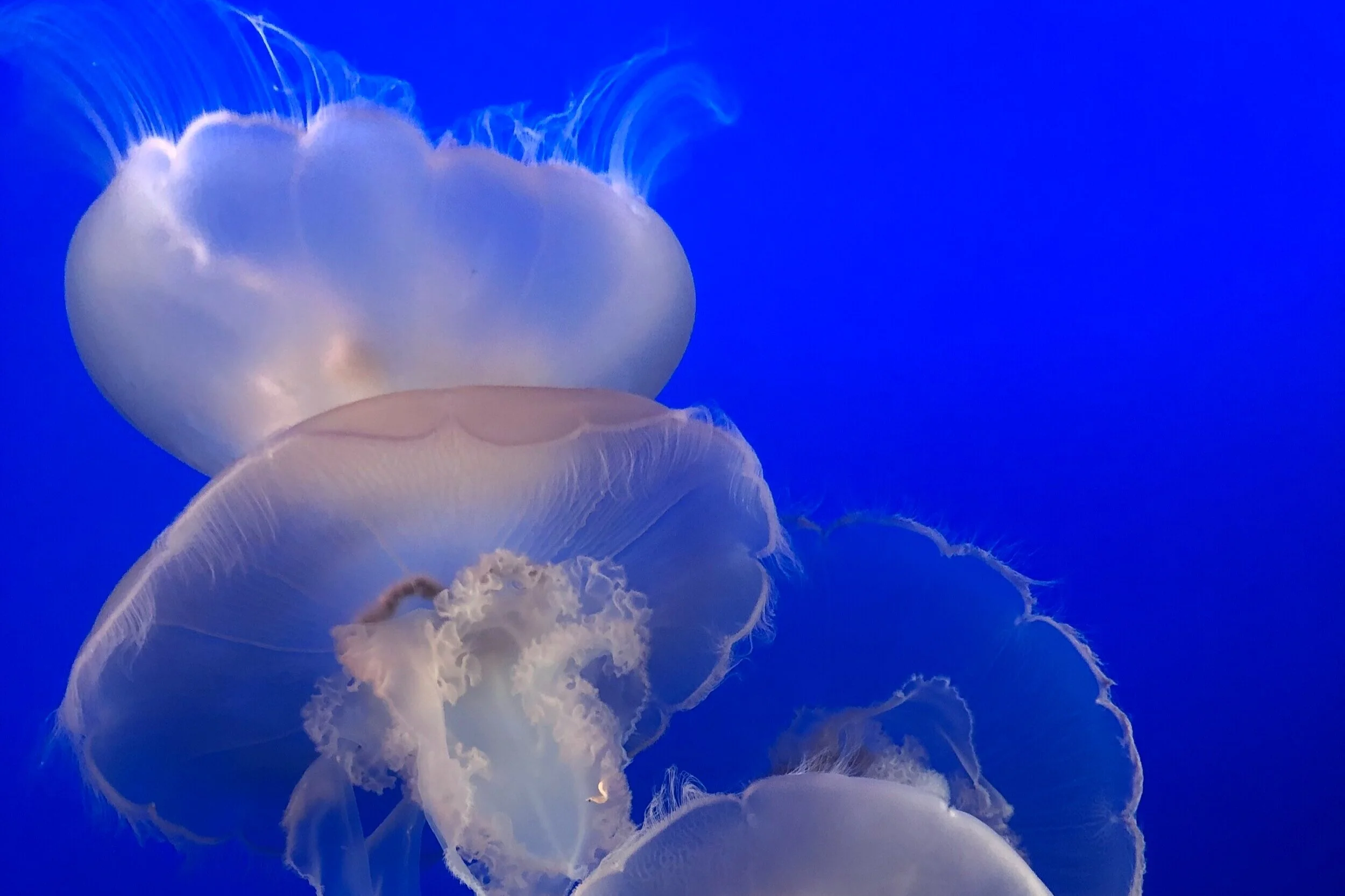Are We Helping the Jellyfish or Are They Helping Us?
Photo: Meredith Beeson
It’s squishy, lacks a brain and may be one of the few animals to thank humans for the warmer sea temperatures and acidifying ocean that are a result of climate change. The jellyfish, also known as a gelatinous zooplankton, colonized the seas nearly 500 million years ago and have lived through many climatic events in the Earth’s history.(1) Perhaps it comes as no surprise then, that while coral reefs are dying and fish are migrating to colder waters, studies show that jellyfish are seemingly thriving in today’s changing marine environment.
Often seen as a stinging nuisance to snorkeling tourists, these alien-like creatures that range anywhere from half an inch to six feet wide, do more than just leave people with a painful memory of their trip to the tropics.(2) From clogging seawater intake screens at both desalination plants and nuclear power plants to infiltrating fish farms, jellyfish have been shown to play a large role not only in our fisheries, but even in sequestering carbon from the atmosphere.(3,4)
Warm and polluted waters—no problem for the jellies
As global ocean waters warm, more and more species are fleeing poleward in search of cooler waters, including animals at the base of the food web like plankton and important fishery species like Herring. While many species’ ranges are shifting and some become forced to adapt to a narrow range of the ocean, jellyfish are embracing the warmer temperatures.(5) Consisting of about 98% water, jellyfish are simple organisms that are equipped to adapt to different ocean conditions.(6) As they expand their territory, jellyfish are now being found in strange, new places. Just earlier this year, a massive jellyfish was seen meandering its way through the canals in Venice.
Not only can they tolerate changing sea temperatures, but it appears that they can survive in oxygen-depleted areas as well. When agricultural runoff containing nutrients like nitrogen and phosphorus enters our waterways, it leads to eutrophication. Algae, or phytoplankton, populations erupt and cover the surface of the ocean. As they die, these organisms sink and use up oxygen in deeper waters as they decompose. These hypoxic areas are called ‘dead zones,’ and fish either die or are forced to migrate to waters with more oxygen. Oddly enough, jellyfish are still found in these eutrophic waters that are devoid of much other marine life.(5) Jellyfish are able to tolerate much lower levels of oxygen, allowing them to live in areas that many species can’t survive in.
Unfortunately, scientists have begun to recognize what these persistent jellyfish blooms really signify. Since jellyfish can thrive in polluted, warm and hypoxic conditions, massive populations that persist and spread are often a sign that the ocean is in a state of stress.
From prey to predators
Humans have also aided this global jellyfish boom by eliminating their predators. As the demand for seafood continues to rise throughout the world, intense fishing pressure has led to the decline of many fish species. People have done a notable job of overfishing species at higher trophic levels, like tuna and various sea turtles, which are some of the main predators of jellyfish.
And while there may be less fish eating the jellyfish, that isn’t stopping jellyfish from consuming the fish. These silent sea drifters are voracious predators of fish eggs and fish larvae - which can put a significant strain on important fishery species that are trying to recover. There have also been multiple occasions when stinger jellyfish have infiltrated salmon farms and killed hundreds of thousands of salmon.(7)
Climate change might be helping them, but could they help mitigate climate change?
While an ocean filled with floating gelatinous creatures might sound a little dreary, a recent study shows that there could be some massive benefits to mitigate climate change. Apparently, gelatinous zooplankton, like jellyfish and salps, play a substantial role in sequestering carbon to the deep sea and providing food for deep sea marine life.(3)
When their food source begins to disappear, large congregations of jellyfish often experience a mass die off, what scientists call “jelly falls.” As their carcasses quickly sink, the carbon stored in their bodies is transported to the deep sea. Gelatinous zooplankton are estimated to be responsible for sequestering nearly 1.8 billion metric tons of carbon in the deep ocean, and jelly falls may help sequester between 8% and 35% more carbon than originally predicted.(3)
As sea temperatures continue to rise, it is possible that jellyfish blooms will become increasingly common. Ironically, as climate change creates conditions that favor jellyfish, the jellyfish may be the key to help sequester the very atmospheric carbon that is leading to warmer sea temperatures and the domination of this marine animal.
Sources:
1. Sean Fleming. “Jellyfish Are Taking over the World – and Climate Change Could Be to Blame.” World Economic Forum, 2019, www.weforum.org/agenda/2019/01/how-an-explosion-of-jellyfish-is-wreaking-havoc/.
2. The Ocean Portal Team Reviewed by Allen Collins. “Jellyfish and Comb Jellies.” Smithsonian Ocean, 22 Mar. 2019, ocean.si.edu/ocean-life/invertebrates/jellyfish-and-comb-jellies.
3. Luo, Jessica Y., et al. “Gelatinous Zooplankton‐Mediated Carbon Flows in the Global Oceans: A Data‐Driven Modeling Study.” Global Biogeochemical Cycles, vol. 34, no. 9, 2020.
4. Purcell, Je, et al. “Anthropogenic Causes of Jellyfish Blooms and Their Direct Consequences for Humans: a Review.” Marine Ecology Progress Series, vol. 350, 2007, pp. 153–174., doi:10.3354/meps07093.
5. Boero, Ferdinando, et. al. IUCN, 2016, pp. 213–237, 3.10 Impacts and Effects of Ocean Warming on Jellyfish, www.researchgate.net/profile/Serena_Zampardi/publication/309209466_Ocean_Warming_310_Impacts_and_effects_of_ocean_warming_on_jellyfish/links/5805c63b08aee314f68e2b71.pdf.
6. Institut de Recherche pour le Développement (IRD). "Boom in jellyfish: Overfishing called into question." ScienceDaily. ScienceDaily, 3 May 2013. <www.sciencedaily.com/releases/2013/05/130503094700.htm>.
7. Bosch-Belmar, Mar, et al. “Jellyfish Impacts on Marine Aquaculture and Fisheries.” Reviews in Fisheries Science & Aquaculture, 2020, pp. 1–18., doi:10.1080/23308249.2020.1806201.
